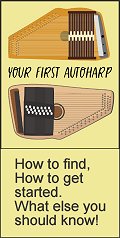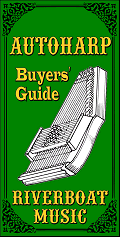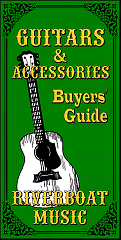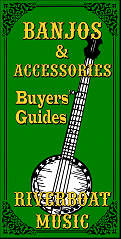 
The Five-Chord Wonder |
| 




|
Zimmermann's 5-chord autoharp design (Model 2 3/4) was probably invented about 1885. It changed shape, color, and labeling several times over its 77-year lifespan, but it kept the same model number and popularity right up until its demise in 1964. What's interesting to me is
| ||||||||||||||||||||||||||||||||||||||||||||||||||||||||||||||||||||||||||||||||||||||||||||||||||||||||||||||||||||||||||||||||||||||||||||||||||||||||||||||||||||||||||||||||||||||||||||||||||||||||||||||||||||||||||||||||||||||||||||||||||||||||||||||||||||||
| Note Name | G | C | F | G | A | B | C | D | E | F | G | A | B | C | D | E | F | G | A | B | C |
| String Number | 5 | 1 | 4 | 5 | 6 | 7 | 1 | 2 | 3 | 4 | 5 | 6 | 7 | 1 | 2 | 3 | 4 | 5 | 6 | 7 | 1 |
Finding the Notes
You could play a C scale simply by finding the middle C and picking D, E, F, etc. without pressing the chord bars. You could pick a melody the same way. That's how zither players do it, after all. But at the end you'd have a confusing cacophony of tones.
Zimmermann's expectation would have been for you to press the chord bar that contained the note you needed. That way the strings next to the one you mean to play will be deadened, so the melody will be clearer. You'd release the chord bar as soon as the note was played, then press the chord bar that you needed for the next note.
Note: - We put the chord bar names in the following graphic, but all Zimmerman gave you on his version was the chord bar numbers, so we give you those, too.
| Note Name | |||||||||||||||
| String Number | |||||||||||||||
| Chord Bar You Would Push Down | (1) | (5) | (1) | (4) or G7 (5) | (1) or G7 (5) | (4) | (5) | (1) | (5) | (1) | (4) or G7 (5) | (1) or G7 (5) | (4) | (5) | (1) |
It may seem strange to press a different chord bar every time you need a different note, but that is why Zimmerman designed the chord bars the way he did. In most three-chord songs in C, G7 is used more often than F, especially for passing tones. That's why the G7 chord bar is next to the C.
Why not C, G7, F? - If you're playing an autoharp in upright position, you'll notice that the tonic note (in this case C) is under your ring finger, not your forefinger. But, remember, these were designed to be played in front of you, on a table or your lap. In that case, the tonic would have been under your forefinger and F, which is played least often, would have been under your ring finger.
Playing a Melody
To play a melody, you would follow the chord chart of the song. Once you knew which chord button to push, you could look at the note names or note numbers down on the right end of the 'harp to see which string to pick. Or you could just strum until you heard the note, and try to remember your hand position.
Remember, the autoharps at this time were designed to be played on a lap or table, and you would strum or flatpick over the little note name/number strip. So finding the melody note wasn't as hard as it sounds.
Here's a simple three-chord song to give you an idea of how the melody and the chords would go together. We include the note and chord numbers in case you have an early autoharp that uses Zimmermann's numbering scheme.

If you played the right chord, the strings next to each melody note would be dampened, so you could be a little sloppy and still attain the melody note.
In "Boil That Cabbage Down," every note in the song is contained in the chords. What do you do if there are other notes? Here's an example. Even though the song "Buffalo Gals" can be accompanied with only two chords, the melody includes "passing tones" that aren't in the chord.
In this case, the "A" passing tones can be found in the F chord. Theoretically, you could pop out to that chord for one half-beat just to hit that note, and then get back to the C chord for the rest of the measure*. That's why the chord bars are kept so close together.

Going From Three to Five
If you tried the songs above, you may have noticed that at least one of them is not in your best vocal range. To help autoharp customers sing songs in keys that suited the, Zimmerman added two more chord bars: C7 and Bb (indicated by a 1 with a line under it and a 6 in dotted lines).
This enabled owners to play 3-chord songs in F as well as C.
In fact, once you learned a song in C, you could play the same song in F just by moving your left hand over two buttons width and adjusting the position of your right hand over the strings.
Two Three-Chord Autoharps in One
 As a Folksinger used to thinking of autoharps as a chord instrument rather than a melodic instrument, I wondered why Zimmerman didn't use the extra two chord bars to support more keys. Say Bb, F, C, G, D7, which would allow you to play in F, C, and G.
As a Folksinger used to thinking of autoharps as a chord instrument rather than a melodic instrument, I wondered why Zimmerman didn't use the extra two chord bars to support more keys. Say Bb, F, C, G, D7, which would allow you to play in F, C, and G.
But Zimmermann wanted to support folks who had learned to play melodies with his three-chord system. What he designed was, essentially a 3-chord instrument for playing songs in C, plus a 3-chord instrument for playing songs in F.
There was no expectation that a player playing a song in F would ever play the C natural or G7 chord bar.**
Bb or A#?
One source of confusion is that Zimmerman labeled the Bb chord bar "6" with a dotted outline. In Zimmerman's numbering scheme, a dotted outline means that the note is sharped. So A, which Zimmerman called "6" was "sharpened" by putting it in dotted letters on the chord bar.
That doesn't explain why Bb is indicated in the note name/number strips as 7 in pale lettering. (B natural is a 7 in standard lettering.)
It's not surprising that when the Oscar Schmidt company took the line over, they eventually ditched Zimmerman's numbering scheme and just put normal chord and note names on the things.
The following graphic shows the contents of the paper strip on the 5-chord model 2 3/4. You'll see that it's diatonic except for the addition of Bb.
| Note Name | G | C | F | G | A | Bb | B | C | D | E | F | G | A | Bb | B | C | D | E | F | G | A | Bb | B | C |
| String Number | 5 | 1 | 4 | 5 | 6 | 7 | 7 | 1 | 2 | 3 | 4 | 5 | 6 | 7 | 7 | 1 | 2 | 3 | 4 | 5 | 6 | 7 | 7 | 1 |
The F Scale Playing a scale or melody on the 5-chord 'harps was just a little bit complicated by that pesky Bb string. So you had to learn to accommodate for that. But once you did, you could happily play any 3-chord song you knew in either C or F.
Note: In Zimmermann's system, C was always note number 1, no matter what key you were playing in. Which makes the note numbers on the following graphic very confusing to modern players. This is just posted for reference purposes - and it's safe to ignore the note numbers. Later Models 2 3/4 omit them altogether.
| Note Name | |||||||||||||||
| String Number | |||||||||||||||
| Chord Bar You Would Push Down | (4) | (17) | (1) | (6) or C7 (17) | (4) or C7 (17) | (6) | (17) | (4) | (17) | (1) | (6) or C7 (17) | (4) or C7 (17) | (6) | (17) | (4) |
An Undeniable Success
Zimmermann designed the Model 2 3/4 and probably built the first units. He also designed 'harps with more chords and features.When Dolge bought Zimmermann's autoharp line (1892), he manufactured several of those designs. But the 5-chord Model 2 3/4 became and stayed so popular that Dolge deemed it "The Favorite." For several production years, that's how it was labeled.
It remained one of the three most popular models when Phonoharp took over the autoharp business about 1910, thought Phonoharp continued to make several other models.
When the Oscar Schmidt company took over the business in the 1930s, the depression was just getting started. OS dropped the least popular models, but kept the Model 2 3/4 and Model 73 (12-chorder) going until the 1960s.
 They also started putting standard chord names on the chord bars and eventually ditched Zimmermann's arcane numbering system once and for all.
They also started putting standard chord names on the chord bars and eventually ditched Zimmermann's arcane numbering system once and for all.
Though 12-chord autoharps were widely available, they were more expensive. And the chord bar arrangement of the Model 2 3/4 was echoed in the larger instruments, which made the 5-chorders a legitimate, and much less expensive, "gateway" instrument.
More Chord Expansion - The Model 2 3/4's ability to play in F and C was so popular that when Zimmerman expanded to the 8-chord Model 72 7/8 (1895), he simply added chords that made it possible to play more complex songs in F and C. (That's the model Sarah Carter started out recording and touring with, so the extra chords definitely gave it some appeal. However, the Model 72 7/8 was later dropped as the 12-chord Model 73 gained prominence.)
When Zimmermann expanded to 12 chords for the Model 73 (about 1898), he kept the Bb/C7/F/G7/C chord layout in the bottom row, adding a G at the right end and sneaking a D7 into the second row there, enabling you to play 3-chord songs in G.
About fifty years later, the Oscar Schmidt company created a 15-chord layout, adding Eb and F7 at the other end, so you could play songs in Bb, exactly the same way you played them in F or C on the 5-chorders. They also sneaked in a D major on the second row there, which would theoretically let you play 3-chord songs in D, but it wasn't easy, because the G you needed for that key was a the other end of the row.
Yes, both the 12- and 15-chord autoharps added more strings, with more sharp and flat notes, but you get the idea. The Model 2 3/4's influence is still felt in all 15-chord Oscar Schmidt and Chromaharp 'harps to this day..
 |
 |
By the early 1960s, improvements in manufacturing approaches made 15-chorders almost as cheap to make as 12-chorders, so the Model 73 was eclipsed.
Glen Peterson, who began rethinking product design for Oscar Schmidt's autoharps in 1963, determined that the 5-chord and 12-chord models were essentially redundant. He discontinued the Model 2 3/4 in 1964. Still, a 79-year run is nothing to turn your nose up at.
 The EasyChord, a six-chord, child-sized autoharp, was introduced in 1980, but its chord layout no longer allowed you to change keys simply by moving your hand over, as you could with the 5, 12, and 15-chorders.
The EasyChord, a six-chord, child-sized autoharp, was introduced in 1980, but its chord layout no longer allowed you to change keys simply by moving your hand over, as you could with the 5, 12, and 15-chorders.
Ironically, Chromaharp's competition, the MiniHarp uses the original 5 chords from the Model 2 3/4, but does not use the same chord bar sequence, so you can't play in G, and you can't play songs you learned in C in F simply by moving your hand over. In case you wondered. The MiniHarp was probably the last 5-chord autoharp built for American customers, but it's not as useful as an EasyChord or a restored Model 2 3/4.
What Are They Good For Now?
Because so many of these were made, quite a few have survived in playable or at least restorable condition. The strings were made by a piano string company, so if the 'harp has been stored properly, the strings may still sound good.They are an excellent introduction to general musicianship, helping kids to enjoy the thrill of making music as well as helping them learn notes and scales. (The "EasyChord" was designed for that purpose, but this one works just as well for that, and - frankly - it sounds better. Yes, I've come across some that are in pretty bad shape, but it's surprising how many I come across that look five years old instead of sixty.
They are an excellent introduction to autoharps in general. As mentioned before, anyone who starts on one of these can easily transfer his or her skill directly to modern 15-chorders. (Ironically, the Model 2 3/4 is a better introduction to the 15-chorder than the 15-chorder is to the 21-chorder. The latter uses a chord bar layout that makes much more sense to musicians but is substantially different from the 15-chorders.)
They are good for people with short arms. You can decide if you want to spring for a Evo Bluestein Sparrow or some other narrow autoharp later, while enjoying this one as soon as you find a playable instrument.
Conclusion
 As I write this in 2024, the Model 2 3/4 is 139 years old. I have an individual model from about 1887 that still plays and looks great. Plus several from later eras - they're not hard to come by. They changed size, shape, color, and labeling over the years, but they kept the same 21 strings and 5 chords from the beginning to the very end.
As I write this in 2024, the Model 2 3/4 is 139 years old. I have an individual model from about 1887 that still plays and looks great. Plus several from later eras - they're not hard to come by. They changed size, shape, color, and labeling over the years, but they kept the same 21 strings and 5 chords from the beginning to the very end.
Not only did it survive as a marketable product for 79 years, but it heavily influenced the design of four subsequent models, one of which is still made today. Yes, they may look like limited toys today, but they played a major role in the growth and development of the autoharp over the years.
And they're still delightful to play if you come across one in playable or restorable condition. Some days it's a lot easier to sit down with a "3/4-size" instrument that still sounds good.
*If you can play precisely with your right hand you could just release all of the chord bars just long enough to play the passing note. For example, on "Buffalo Gals," you could play the C(1) chord for the first measure, release that chord bar just long enough to pick the A at the beginning of the second measure, then press down the G7(5) for rest of the measure. This approach works on this autoharp (and most other diatonic autoharps) because any notes you happen to hit when you're picking the A won't clash too much with the A. Players of diatonic autoharps call this "open chording."
**The songs Zimmermann had commissioned for the things never included secondary dominants, in case the music theory fans are questioning that statement. If you don't know what the means, don't worry about it.
As I do more conversions and repairs, I expect my list of articles to continue growing. The articles I feel relate most to autoharp history are listed below.
- Autoharp Precursors and Competitors - Before the kind of autoharps we know and love came on the market, countless other instruments that also purported to make anyone a musician appeared. Most of these are mis-labeled "autoharp" when they appear on the used market, and too many folks have bought unsuitable instruments (or wall decorations) as a result. This is an over of the major classes of these autoharp precursors.
- Early Autoharp Chord and Note Numbers What's with the weird labeling system on early 3, 4, and 5-chord autoharps, and why do they label both A and Bb as note number 6?
- Shifter Autoharps - Discontinued by 1926, these somewhat "overengineered" instruments allowed you to play up to 16 chords with just six buttons, plus some little levers you'd squeeze.
- Autoharp Factory Chord Layouts - Describes the four most common chord layouts for new autoharps, and most historical variations.
- Mountain Music, Bluegrass, and Autoharps - How autoharps were used in early string bands and "Mountain Music," and why you don't see them as much in Bluegrass or Folk.
- Is my Autoharp a Type A or Type B? - In 1968, following Chromaharp's lead, Oscar Schmidt reconfigured their instruments to be more ergonomic. They also changed the string attachment and removed the bridge. A late model A may still be a very playable instrument, but used model Bs tend to be in better playing condition just because they're newer. Either way, if you want to restring an autoharp, you'll find out that the strings are different between the two models. How do you find out which one you have?
- Hopf Autoharps
- Musima Autoharps
More articles are likely to come soon. In the meantime, I hope these articles help answer your questions about these under-rated instruments.
 Whatever else you get out of our pages, I hope you come away with some great ideas for "sharing the joy."
Whatever else you get out of our pages, I hope you come away with some great ideas for "sharing the joy."
And please stay in touch!
All material, illustrations, and content of this web site is copyrighted ? 2001, 2002, 2003, 2004, 2005, 2006,
2007, 2008, 2009, 2010, 2011, 2012, 2013, 2014, 2015, 2016, 2017 by Paul D. Race. All rights reserved.
Creek Dont' Rise(tm) is a participant in the Amazon Services LLC Associates Program, an affiliate advertising
program designed to provide a means for sites to earn advertising fees by advertising and linking to Amazon.com.
For questions, comments, suggestions, trouble reports, etc. about this page or this site, please contact us.
| Visit related pages and affiliated sites: | |||||
| - Music - | |||||

|
 |
 |

|

|

|

|

|

|

|

|

|

|

|

|

|

|

|
| - Trains and Hobbies - | |||||
 |

|

|  |
 |

|
| - Christmas Memories and Collectibles - | |||||
 |

|
 |

|
 |

|
| - Family Activities and Crafts - | |||||
 |

|

|

|

|

|

 To put it as simply as possible, the melody of a "three-chorder" in the key of C stays within the notes of the C scale (C. D. E. F. G. A. B. C). And each of those notes is contained in one or more of the following three chords:
To put it as simply as possible, the melody of a "three-chorder" in the key of C stays within the notes of the C scale (C. D. E. F. G. A. B. C). And each of those notes is contained in one or more of the following three chords:


